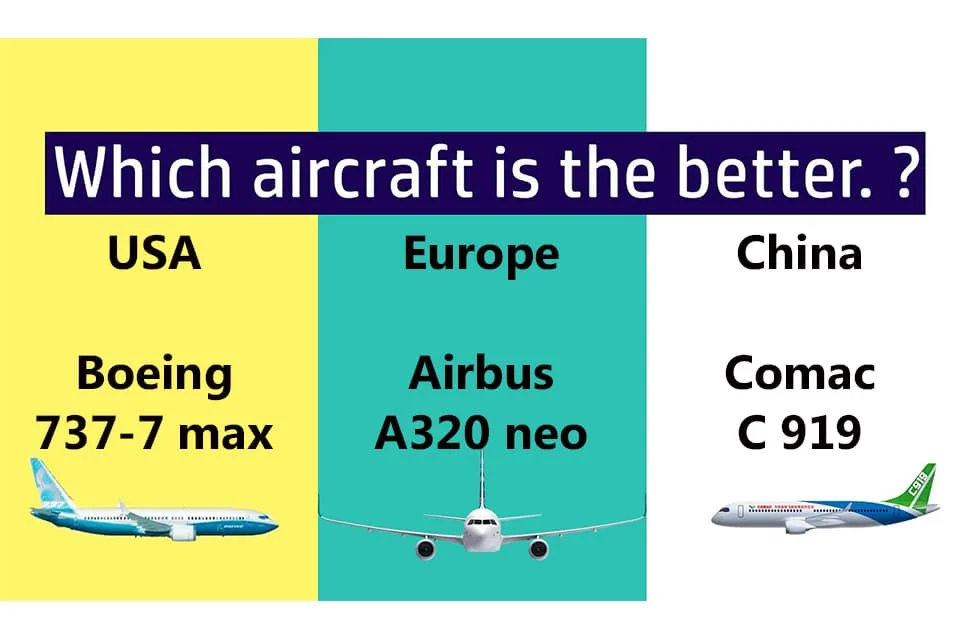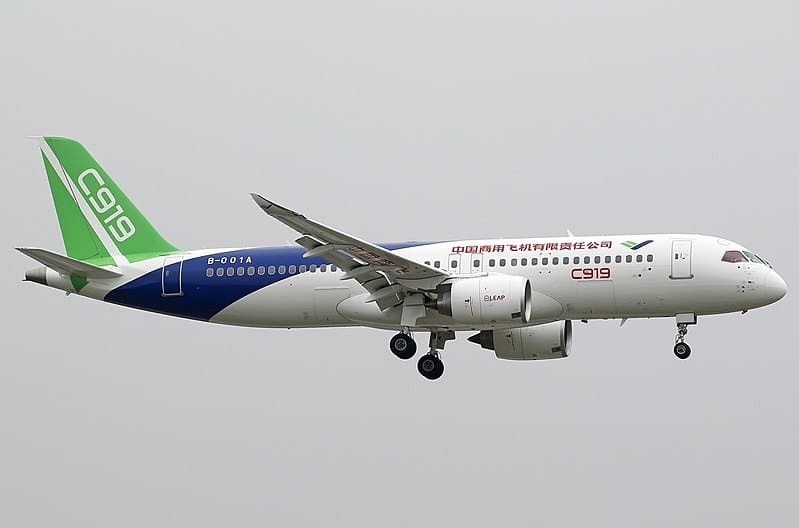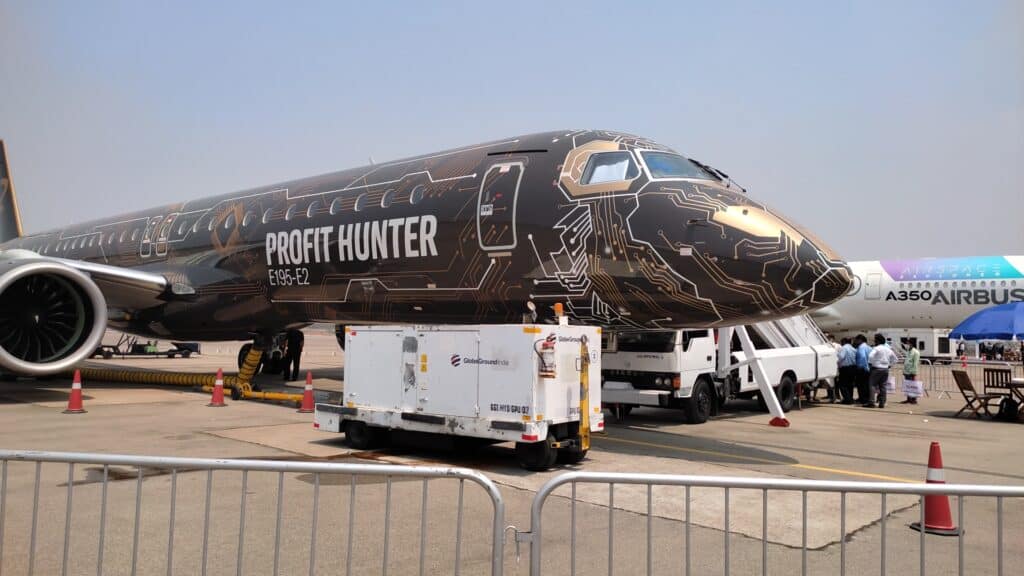Aircraft comparison
Aircraft comparisons between the Chinese built Comac C919 and the Embraer E195-E2.

In this article, we’ll look at the airplane comparison between the Comac C919 and Embraer E195-E2.
China’s COMAC C919 Narrow-body aircraft.
The C919 is the first domestic product of China that will be developed along with COMAC Company for both narrow and wide-body aircraft. The program was launched in 2008, and the first prototype was finished in 2015. It then underwent numerous tests in China to demonstrate its capabilities. Finally, on September 29th, 2022, it received the first Airworthiness Certificate from the Chinese Civil Aviation Authority, and on December 9th, 2022, this aircraft will be delivered to China Eastern Airlines in Shanghai.
Currently, there have been 800 orders for aircraft from various clients, with the majority of those orders coming from China. As the continuous sanctions imposed by western nations on Russia. If demand increases, China will be a key player in exporting some Comac aircraft to Russia.
[adinserter block="13"]
Comparison of global 7500 v/s Gulfstream 700
Brazil’s Embraer E195-E2 Narrow-Body aircraft.
The medium-range jet airliner Embraer 195 E2 was created by the Brazilian company Embraer. For small airline operators, it is the most promising jet because it may be used for regional connections. The aircraft was introduced during the 2013 Paris Air Show. 2016 had seen the launch of the E190-E2’s first variant. And in 2018, it began operating in the operations with Wideroe as its first client.
It has three different types of aircraft, depending on the number of seats and trip distance. Embraer targets lower fuel consumption of 16–24% and maintenance costs per seat of 15–25%. Built on the first version of the E-Jet, it features a new fly-by-wire system, new pylons, landing gear, horizontal stabilizers, cabin, cabin air system, air cycle machine, and cabin.
[adinserter block="14"]
Can the J20 from China match the American F-22? Let’s look at it in Comparison.
The Airbus A220 is a direct competitor in this market, and its cost is 91.2 million dollars, whereas the E195-E2’s cost is only $60.4 million. Embraer has currently received an order for 227 E195-E2 aircraft, of which 39 have been delivered to customers.
Comac C919 and Embraer E195-E2 specification
- Comac offers two different seating arrangements, with 168 seats for one class and 158 seats for two classes.
- Additionally, E195-E2 contains 146 seats for the single class and 120 capacity seats for the two classes.
- The C919 aircraft is 127.7 feet long, while the Embraer is 136.2 feet long.
- The c919’s wingspan is 110.3 feet while the Embraer’s is 110.6 feet.
- The C919 is 39.2 feet tall, while the Embraer is 35.8 feet tall.
- While the Embraer can carry 16150 kg, the C919 can carry up to 18900 kg.
- Operating empty, the weighs E195 E2 is 35700 kg and C919 45700 kg, respectively.
- The maximum takeoff weight for the E195-E2 is 61500 kg and for C919 is 78900 kg.
- The C919’s range is approximately 5575 km, while the E195’s range is 4917 km.
- The C919’s CFM engine generates 129.9-kilo newtons of thrust, whereas the Embraer’s two Pratt & Whitney engines can produce up to 102-kilo newtons of thrust.
- The C 919 has a list price of approximately $99 million, while the Embraer costs $60.1 million.

Aircraft comparison
Comparison between Comac C919 and A320 aircraft

The COMAC C919 and the Airbus A320 represent two significant players in the narrow-body commercial aircraft market, each reflecting its manufacturer’s vision for the future of aviation.
The C919, developed by the Chinese aerospace manufacturer COMAC, aims to challenge established Western dominance with its advanced technology and cost-effective design. In contrast, the Airbus A320, a stalwart of global aviation for decades, continues to set benchmarks for efficiency, safety, and passenger comfort.
This comparison explores the key differences and similarities between these two aircraft, highlighting their design philosophies, performance metrics, and market implications.
How the Comac C919 similar from the A320 and B737 Max:Click here
The COMAC C919, predominantly built using aluminum alloys, is equipped with CFM International LEAP turbofan engines. It has the capacity to accommodate between 156 and 168 passengers in its standard configuration.
This twin-engine jet features a six-abreast economy cabin layout. Initially, it offered options for either CFM56 or IAE V2500 turbofan engines, though the CFM56/PW6000 combination was exclusively used for the A318 model. It can accommodate 195 passengers.
COMAC C919 vs. Airbus A320: A Comparative Overview
Length: The C919 measures 38.9 meters (127.6 feet) in length, slightly longer than the A320, which is 37.57 meters (123 feet 3 inches) long. This extra length provides a marginally larger cabin for the C919.
Wingspan: Both aircraft share the same wingspan of 35.8 meters (117.5 feet), indicating similar aerodynamic properties and potential for comparable fuel efficiency and performance.
Height: The C919 stands at 11.95 meters (39.2 feet) in height, surpassing the A320’s height of 11.76 meters (38 feet 7 inches). This difference is relatively minor but may impact cabin space and cargo hold configuration.
Aircraft comparisons between the comac C919 and B737 max 8:Click here
Weight: The COMAC C919 has a maximum takeoff weight of 42,100 kilograms (92,815 pounds), slightly less than the A320’s 42.6 tonnes (93,900 pounds). The A320’s marginally higher weight suggests it may be able to handle slightly more payload or fuel.
Range: The C919 offers a range of 4,630 kilometers (2,500 nautical miles), which is shorter compared to the A320’s range of 6,112 kilometers (3,300 nautical miles). This extended range of the A320 makes it better suited for longer routes and provides airlines with more operational flexibility.
Nearly twice as much as the $50 million that analysts predicted, comac c919 price is roughly $91 million. That is comparable to the cost of the Boeing 737-800 and the Airbus A320neo, which, as of 2021, are estimated to be $106 million and $111 million, respectively.
-

 Travel1 week ago
Travel1 week agoAir India to Expand US Operations with Three New Routes After a Decade
-

 Travel2 weeks ago
Travel2 weeks agoWhy We Should Avoid These Stamps in a Passport
-

 Airlines1 month ago
Airlines1 month agoInvestigations Reveal Fake Chinese Titanium in Boeing and Airbus Jets
-

 Tech4 weeks ago
Tech4 weeks agoChina’s CATL Plans 1,800-Mile Electric Plane Launch by 2027
-

 Airport3 days ago
Airport3 days agoTop 10 Largest Airports in the World by Size
-

 Aerospace4 weeks ago
Aerospace4 weeks agoChina’s Fighter Jets Turn Wings into Autonomous Drones
-

 Airlines4 days ago
Airlines4 days agoAir India Rolls Out A350s for Delhi-New York JFK and Newark Routes
-

 Defence3 weeks ago
Defence3 weeks agoBoeing Enhances Chinook with New Engines and Block II Upgrades at $96 Million









